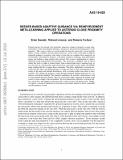| dc.contributor.author | Mario, Courtney | |
| dc.contributor.author | Linares, Richard | |
| dc.contributor.author | Folcik, Zachary James | |
| dc.contributor.author | Miller, Daniel(Daniel Martin) | |
| dc.contributor.author | Hattis, Philip David | |
| dc.contributor.author | Dave, Pratik K. | |
| dc.contributor.author | Cahoy, Kerri | |
| dc.contributor.author | Gondelach, David J | |
| dc.date.accessioned | 2022-08-19T21:05:54Z | |
| dc.date.available | 2021-11-08T18:07:59Z | |
| dc.date.available | 2022-03-21T14:44:58Z | |
| dc.date.available | 2022-08-19T21:05:54Z | |
| dc.date.issued | 2019-08 | |
| dc.identifier.issn | 978-0-87703-666-1 | |
| dc.identifier.uri | https://hdl.handle.net/1721.1/137751.3 | |
| dc.description.abstract | Current practice for asteroid close proximity maneuvers requires extremely accurate characterization of the environmental dynamics and precise spacecraft positioning prior to the maneuver. This creates a delay of several months between the spacecraft’s arrival and the ability to safely complete close proximity maneuvers. In this work we develop an adaptive integrated guidance, navigation, and control system that can complete these maneuvers in environments with unknown dynamics, with initial conditions spanning a large deployment region, and without a shape model of the asteroid. The system is implemented as a policy optimized using reinforcement meta-learning. The spacecraft is equipped with an optical seeker that locks to either a terrain feature, reflected light from a targeting laser, or an active beacon, and the policy maps observations consisting of seeker angles and LIDAR range readings directly to engine thrust commands. The policy implements a recurrent network layer that allows the deployed policy to adapt real time to both environmental forces acting on the agent and internal disturbances such as actuator failure and center of mass variation. We validate the guidance system through simulated landing maneuvers in a six degrees-of-freedom simulator. The simulator randomizes the asteroid’s characteristics such as solar radiation pressure, density, spin rate, and nutation angle, requiring the guidance and control system to adapt to the environment. We also demonstrate robustness to actuator failure, sensor bias, and changes in the spacecraft’s center of mass and inertia tensor. Finally, we suggest a concept of operations for asteroid close proximity maneuvers that is compatible with the guidance system. | en_US |
| dc.language.iso | en | |
| dc.publisher | Univelt, Inc. | en_US |
| dc.relation.isversionof | http://www.univelt.com/linkedfiles/v171%20Contents.pdf | en_US |
| dc.rights | Creative Commons Attribution-Noncommercial-Share Alike | en_US |
| dc.rights.uri | http://creativecommons.org/licenses/by-nc-sa/4.0/ | en_US |
| dc.source | arXiv | en_US |
| dc.title | Seeker-based adaptive guidance via reinforcement meta-learning applied to asteroid close proximity operations | en_US |
| dc.type | Article | en_US |
| dc.identifier.citation | 2019. "Seeker-based adaptive guidance via reinforcement meta-learning applied to asteroid close proximity operations." Advances in the Astronautical Sciences, 171. | en_US |
| dc.contributor.department | Massachusetts Institute of Technology. Department of Aeronautics and Astronautics | en_US |
| dc.contributor.department | Lincoln Laboratory | en_US |
| dc.contributor.department | Charles Stark Draper Laboratory | en_US |
| dc.relation.journal | Advances in the Astronautical Sciences | en_US |
| dc.eprint.version | Author's final manuscript | en_US |
| dc.type.uri | http://purl.org/eprint/type/ConferencePaper | en_US |
| eprint.status | http://purl.org/eprint/status/NonPeerReviewed | en_US |
| dc.date.updated | 2021-05-06T14:13:20Z | |
| dspace.orderedauthors | Gaudet, B; Linares, R; Furfaro, R | en_US |
| dspace.date.submission | 2021-05-06T14:13:21Z | |
| mit.journal.volume | 171 | en_US |
| mit.license | OPEN_ACCESS_POLICY | |
| mit.metadata.status | Ready for Final Review | en_US |
